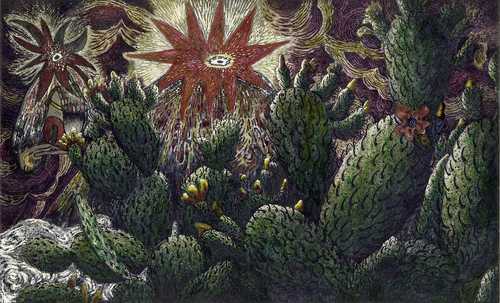The exhibition In celicayotl in itzmolincayotlby Santiago Robles Bonfil (Mexico City, 1984), brings together questions about the interpretation of founding myths of our society in a context of late capitalism or globalization. Installed at the Autonomous University of Chapingo, alongside murals on social justice and the Mexican countryside painted a century ago by Diego Rivera and Xavier Guerrero, it reflects on pre-Hispanic roots, traditions and the relationship with the cornfield.
The works at the National Museum of Agriculture in that university are a review of the artist’s last decade of production. Some 40 pieces are presented, including drawings, paintings, engravings, ceramics, a codex and altarpieces made with corn grains and pre-Hispanic dyes. The title translated from Nahuatl means Freshness, germination.
It is a brief but very consistent anthology that begins with works from 2014 and concludes with some that I finished a few weeks ago in the engraving workshop at the Los Pinos Cultural Complex. They are lithographs that deal with the subject of corn.
says Santiago Robles in a conversation on the occasion of this retrospective.
Above all, what I consider particular about this exhibition is that it contains materials used since pre-Hispanic times, such as indigo, cochineal or pericón dyes, which were used to make murals in the pyramids or the codices themselves, along with other materials that are generally much more modern, such as oil paint or acrylic.
In your opinion, For Mexicans, the countryside is fundamental. Not only are we the center of a great diversity of corn in the world
but as part of the milpa, tomatoes, pumpkins and a wide variety of foods stand out, says the artist who graduated from the Faculty of Arts and Design (FAD) of the National Autonomous University of Mexico.
The chapel in the old hacienda’s hull displays the mural Song to the Earthwhich Diego Rivera (1886-1957) captured on its walls and ceilings, It’s like the Sistine Chapel, but revolutionary.
where he expressed the theme of social justice in the rural sector. These works in the 17th century building were commissioned when the agricultural school moved to Texcoco at the beginning of the last century.
The then young artist Xavier Guerrero (1896-1974), a pioneer of the muralist movement, created his own work at this school between 1923 and 1927. In two murals he alluded to capitalism and social justice, while in nine panels, as well as 11 panels and grisailles, he included socialist symbols, those of Freemasonry, along with angels and clouds. Much of his work has disappeared, but one of the best collections of this Coahuila artist is found at the Autonomous University of Chapingo.
Santiago Robles, who used to visit the university frequently to admire the works, says that when he received the invitation to present his work he thought it was the ideal place.
Together with curator Christian Barragán, the idea was to maintain a dialogue with the murals of Guerrero and Rivera, as well as with the richness of the National Museum of Agriculture collection.
Founded in 1987, the museum’s mission is to preserve the artistic heritage and provide an overview of the most important activity of the Mexican people throughout the centuries: agriculture
.
In addition to housing the school dedicated to the countryside, Texcoco has a deep history, which goes back a long time
. There are the baths of Nezahualcóyotl, who had a botanical garden and a water system to supply water to the city. In addition, the brigantines of Hernán Cortés that attacked Tenochtitlan for water left from Lake Texcoco, Robles Bonfil lists.
This museum reflects our ancient relationship with the cornfield, our food and cultural source; for example, our calendar is based on the cornfield cycle and patron saint festivals.
Curator Christian Barragán details in the museum text that the art created by the Mexican artist It exercises the possibility of moving from the individual to the communal, from what is one’s own to what is foreign, from the past to the present, from ethics to aesthetics. The potential of the art he practises lies in social action, in exercising it on a daily basis, in the complicity of the other, in the willingness to know and reflect on others.
.
The National Museum of Agriculture of the Autonomous University of Chapingo is located at kilometer 38.5 of the Mexico-Texcoco Chapingo highway, in the state of Mexico, and can be visited from Monday to Friday from 10 a.m. to 3 p.m.; Saturdays and Sundays, from 10 a.m. to 5 p.m.
